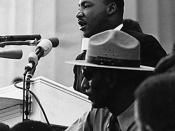In his letter from a Birmingham Jail, Martin Luther King Jr. employs many rhetorical techniques in order to persuade his audience to understand his ideologies. MLK uses diction and pathos, as well as allusions to solidify his arguments throughout the letter.
Martin Luther King Jr. makes careful choices in his diction which strengthen his arguments. He makes an effort to not offend or criticize his readers. He begins the letter with, "My Dear Fellow Clergymen." (p261, ö1) This not only establishes a connection with his readers, but this is also a utilization of logos. With this line, MLK ensures the readers will not be offended, as well as makes them believe he is looking at the situation from a logical standpoint. Throughout the letter, Dr. King continues to make connections with not only the clergymen but to all people. The line "With his black brothers of Africa and his brown and yellow brothers of Asia, South America and the Caribbean," (p269 ö30), MLK establishes a connection with all races and people, showing he is a man of equality and justice.
He consistently uses the word "brothers," even when referring to whites to show he bears no hatred for them. (p270 ö33) He appears to merely try to get the readers to see the injustice of segregation and not trying to disparage the clergymen's opinions. MLK's use of diction gives him credibility as he establishes connections with the audience and comes off as a reasonable person.
Martin Luther King Jr. also appeals to the readers' pathos throughout his letter as an attempt to convince them about the immoral nature of segregation. MLK uses examples of segregation in society and how it negatively affects the people who are subjected to injustice. His story about the girl who can't go to...


